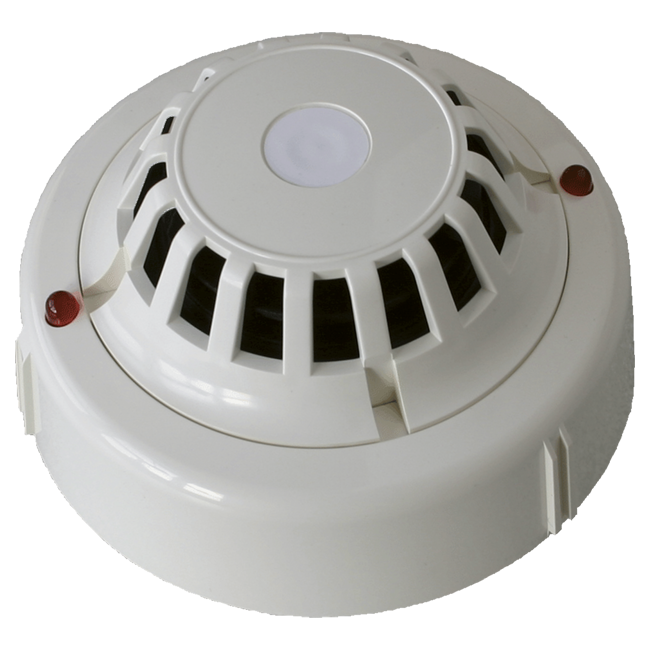MHG 862V0
Multisensor Detector
Ineractive Multisensor detector with extended spectrum of detected smokes is intended for the automatic fire alarm signalling as a multisensor detector in autonomous applications and in FDFAS for railway wagons.

Ineractive Multisensor detector with extended spectrum of detected smokes is intended for the automatic fire alarm signalling as a multisensor detector in autonomous applications and in FDFAS for railway wagons.
The detector combines two principles at its function - it responds to smoke particles on the principle of detection of scattered blue radiation, and it also responds to temperature and its changes.
Detector MHG 862V0 is a conventional (non-addressable) detector derived from interactive addressable detector MHG 862i. Detector connects to an autonomous mounting base MHY 734.037 with screw terminals or to base MHY 734.038 with crimp connector. For use in railway wagons the detector connects to the MHY 734.029V0 mounting base.
The detector contains a program that evaluates the fire situation pursuant to measuring of surrounding temperature and smoke concentration, namely in agreement with the followingadjustable characteristics:
- sensitivity of the detector; it monitors the surrounding smoke concentration increase compared to the quiescent state, that compensates the climatic and other influences continuously; the sensitivity can be adjusted in three degrees that must be selected with reference to the detectors combustion gas load that the detector responds to
- reaction time; it is the verification level of the fire situation; also adjustable in two degrees, however they can’t be expressed by a simple time stamp, because the reaction time depends on the time progression of the fire situation
- dust monitoring; it monitors the quiescent level of the detector, and upon this it evaluates the dustiness rate of the optical chamber and consequently the reliability of the detector; itcan be turned on or disabled; it’s set in reference to the dust nuisance rate round the detector and to the setting of other parameters the threshold temperature - at this temperature level the fire alarm puts on; it can be set in the interval 45°C - 90°C at 3°C
- temperature change that leads to an alarm (so-called differential part); it may be set in the interval 10°C - 45°C at 5°C; eventually the reaction to a temperature change may be notallowed
- the minimum average speed (steepness) of the temperature increase so that it comes to a respond to the differential part, if it`s allowed; it may be set at c. 3°C/min or 10°C/min
- the minimum temperature that must be reached at a fire alarm and also at the reaction of the differential part; it can be set from 0°C up to the threshold temperature in sevenequidistant steps
- the way/mode of combining the effects of the optical and the temperature part of the Multisensor detector for the alarm making; the single parts can react either separately (through the program one of the sensors is disconnected), or independent (at least one sensor must signalize), together (both sensors must signalize), or their effects can be summed up.
Adjustable parameters are set by the MHY 536 (535) addressing preparation.
Detector MHG 862V0 has built-in circuit which at detector’s fault (e.g. too dusty) disconnects the positive terminals +L1 and +L2, that are in normal state connected. This circuit is used for fault signalling.
When installing the detector to high places, the MHY 736 mounting head on a rod can be used.
The detectors comply with ČSN EN 54-7 standard and are subject to conformity assessment according to Act No. 22/1997 Sb., As amended by Act No. 71/2000 Sb. and relevant government regulations.
| Technical parameters | |
|---|---|
| Power supply | autonomous mounting base or railway FDFAS LITES |
| Optical signalling | couple of red LEDs |
| Testing | testing rod MHY 506 |
| Threshold temperature | adjustable 45 °C ÷ 90 °C |
| Protection according to ČSN EN 60529 | IP 43 |
| Radio screening degree according to ČSN EN 55022 | B class equipment |
| Checking and setting of parameters | addressing preparation MHY 536 |
| Dimensions | (Ø98 × 58) mm |
| Weight | 120 g |
| Non-flammability of plastics | according to UL 94 - V0 |
Product is intended for operation with safe equipment in sense of ČSN EN 60950.
| Working conditions | |
|---|---|
| Application of the detector is in areas protected against weather conditions with classification according to ČSN EN 60721-3-3 | |
| K: climatic conditions for environment | 3K5 |
| - working temperature range | -25°C ÷ +70°C |
| - max. relative humidity | 95 % at 40°C |
| - without condensation and ice accretion | |
| Z: special conditions | 3Z1 heat radiation negligible, 3Z8 irrigation water |
| B: biological conditions | 3B1 without presence of flora and fauna |
| C: chemical active substances | 3C2 |
| S: mechanical active substances | 3S1 |
| M: mechanical conditions | 3M2 |
| Duration of significant temperature (45°C ÷ 70°C) | 2 months/year |
| Duration of significant humidity (85 % ÷ 95 % / ≤ 40°C) | 100 hours/year |
| Maximum duration of spraying | 10 min/month |